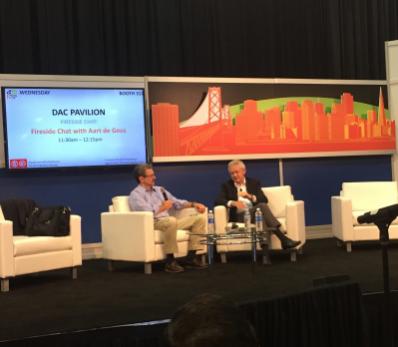 Actually, like anyone who has been in EDA for more than a decade or two (or three) I know quite a bit about Aart. But I still learned quite a bit about his views at the Fireside Chat at DAC where Ed Sperling talked to Aart for three-quarters of an hour.
Actually, like anyone who has been in EDA for more than a decade or two (or three) I know quite a bit about Aart. But I still learned quite a bit about his views at the Fireside Chat at DAC where Ed Sperling talked to Aart for three-quarters of an hour.
Aart has a great talent at taking various small trends in the industry and aggregating them up to a significant trend. Or looking at some aspect of the industry and generalizing it in an interesting way. I won’t try and cover everything (it took Aart 45 minutes to say it and it would take you 45 minutes to read it…not to mention my note-taking skills are not that good.)
One area where Synopsys is different from the other big 3 EDA companies is its recent (starting last year) foray into the software quality and security space with its acquisition of Coverity and a couple of other smaller companies or parts of companies. One of the things that Aart has learned, he said, was never to say something is secure. It is no more plausible than saying that Design Compiler is bug-free. Hopefully things are more secure than they were yesterday, just as hopefully Design Compiler has fewer bugs today. But security is just one angle in the software space, since it is not possible to have secure software if it is poor quality. There is no silver bullet in software quality but many things are pretty easy to check for so it is stupid not to do them.
In the automotive keynote on Tuesday Jeffrey Owens of Delphi pointed out that a car has 100M lines of code, more than Android and Facebook and…well, Aart saw Jeffrey’s 100M and raised him to 400M. Synopsys has 400M lines of code in its portfolio. It invests 31-34% of revenue in R&D. Plus they have done 17 or 18 acquisitions over the years to add additional capability over and above what they invest directly.
Ed asked Aart if internal development was cheaper than acquisition. Aart agreed that it was but the timing is not always right. If a company develops a technology and makes it a commercial success, it may be too late to start an internal project to copy it. This is classic innovator’s dilemma stuff, by the time the future is obvious it is too late. Aart said that VCs are always complaining about bubbles in valuations, but what they really mean is that they want to be inside one. “Lord let there be one more bubble” was a bumper sticker he had seen on Sand Hill Road. But for sure, right now, internet software companies are valued more highly than EDA companies.
Ed asked Aart about Moore’s Law and Dennard’s Law (the one about scaling transistors). Does everything go more slowly? Are there too few companies at the sharpest end of the arrow? I think Aart actually ducked the question by saying that exponential ambition is alive and well in hardware and software and developments in hardware and software will continue for another 30 years or more. For a couple of years Aart has had a keynote built around what he calls Technomics, the combination of economics and technology.

He admits that there are economic challenges and the way that profits in the value chain may need to move. We see some of that already in the big investments that semiconductor companies need to make in equipment companies, especially for EUV, since there is not enough profit in simply selling equipment in the normal way. Similarly foundries have huge capex budgets, $10B for a new fab plus $3B for a new process to put in it. One solution that we have been living through is siloing everything aka disaggregation of the supply chain: materials companies, equipment companies, foundries, fabless design companies, EDA, embedded software and so on. That works for efficiency but often it is breaks down such as now where we are moving from Moore’s law (scale complexity) to systemic complexity. Coooperation is one way to break down silos, but not always that good. Mergers and acquisitions is more forceful.
IoT will change the equation since it is going to use older nodes. But there may not be enough older node capacity. But Aart says that might be a good thing. The memory companies (especially DRAM) have be come much more disciplined about overinvestment. In fact most of the recent growth in semiconductor is entirely due to prices firming in memories. With the big 3 EDA companies going in slightly different directions there is some of that too. “A certain amount of not beating each other into the ground is good.”
Management of all this is a big change since companies are change averse. Change can be driven by stress (no alternative) or courage. Stress is the easy way, but great companies have courage. They are not always successful but courage and perseverance are very valuable. The smoke has not cleared yet but for sure the age of IoT (smart everything) is a massive wave that will impact mankind.
Manufacture + design + EDA has moved the world already and it will continue to do so. But exponential ambition only gets paid for linearly, which is one of the challenges of being courageous.
Share this post via:






Comments
0 Replies to “I Don’t Know Much About Aart…”
You must register or log in to view/post comments.